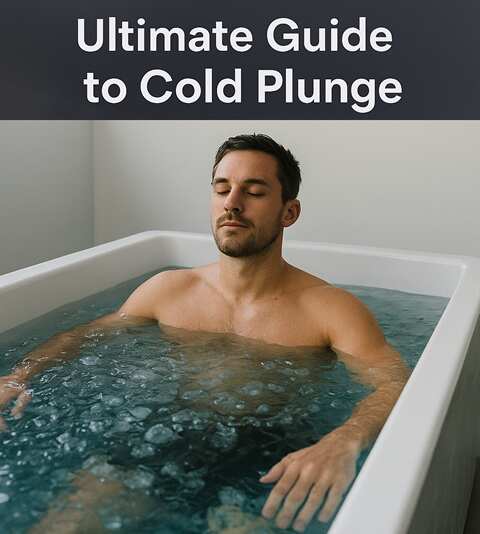Ultimate Guide to Cold Plunge Therapy: Benefits, Risks, and How to Start
Cold plunge therapy has gone from niche athlete ritual to mainstream ritual: influencers, gym owners, and curious beginners are talking about ice baths, plunge tubs, and the brisk, electric jolt of cold water. If the title brought you here, you want practical answers , what it does, what could go wrong, and how to begin without turning your first session into a shock you regret. Read on for a no nonsense, conversational primer.

What is a cold plunge?
A cold plunge, or ice bath, is deliberate immersion in cold water to provoke physiological responses: vasoconstriction, a spike in adrenaline, slowed inflammation, and that unmistakable sense of clarity afterward. People use cold water plunge routines for recovery, mood modulation, and resilience training. You’ll see choices from a simple tub filled with ice to purpose built cold plunge tubs and portable cold plunge units.
Benefits (what people are actually chasing)
- Faster recovery: Many athletes report reduced muscle soreness after training, especially when paired with controlled timing after workouts.
- Improved circulation: Alternating cold with warmth (sauna and cold plunge) creates a vascular workout: vessels constrict in cold, then dilate afterward.
- Mental clarity and mood lift: The shock of cold releases catecholamines and endorphins, which many describe as invigorating.
- Increased resilience: Repeated cold exposure can train your nervous system to tolerate stress better, both physically and mentally.
These benefits vary by person, and outcomes depend on temperature, duration, frequency, and individual physiology.
Risks and when to stop
Cold plunges are not harmless. They stress the heart and blood pressure system, so avoid plunging if you have uncontrolled hypertension, significant heart disease, recent heart surgery, or a history of fainting. People with Raynaud’s, severe asthma, or pregnancy should check with a clinician first. Alcohol or drugs that impair judgment are a strict no while cold plunging.
Temperature and timing , practical guidelines
Temperatures used vary widely. A reasonable starting range for beginners is 10-15ºC (50-59ºF). For reference, 10ºC converts to 50ºF, and 15ºC converts to 59ºF. More advanced users sometimes use colder water, down to around 1-4ºC (33.8-39.2ºF), but that requires experience and caution. Keep sessions short at first:
- Beginners: 30-90 seconds.
- Intermediate: 2-4 minutes, after progressive adaptation.
- Experienced: some go 5-10 minutes, but there’s diminishing return and increasing risk beyond that.
If you feel uncontrolled shivering, dizziness, chest pain, or severe numbness, get out immediately and warm up.
How to start , step by step
- Prepare the environment: towel, warm clothes, non slip mat, and a timer. Have a warm drink ready for afterward if you like.
- Choose your setup: a bathtub with bags of ice, an inflatable cold plunge, a portable cold plunge, or a dedicated cold plunge tub with a chiller. Affordable options exist; many gyms or wellness centers offer “cold plunge near me” so you can try before you buy.
- Warm up first: do a light cardio or dynamic warm up, or use a hot shower or sauna briefly (if doing contrast, follow safe guidelines).
- Enter gradually: sit first, then lie back if comfortable. Control your breath; slow inhales and longer exhales help blunt the gasp reflex.
- Time it: start with short intervals and log how you feel. Increase by small increments over weeks.
- Warm up after: dry off, layer clothing, and sip something warm if needed. Avoid very hot showers immediately; allow your body to normalize.
Tip: breathing is the backbone of a good plunge; if your breath spirals, exit the water. Calm, deliberate breathing reduces panic and makes immersion manageable.
Buying considerations
If you’re shopping, search terms like best cold plunge, inflatable cold plunge, portable cold plunge, or cold plunge for sale will surface different categories: DIY tubs, mid range portable units, and pricier cold plunge pods with chillers. Decide on budget, size, and whether you want a chiller (keeps water cold without daily ice). For many, an inflatable or simple ice bath is a sensible way to try the habit before investing in a permanent plunge tub.
Types and who they suit
- Hard shell tubs (best cold plunge for home): Built for durability and precise temperature control when paired with a chiller. Excellent if you want a permanent installation and the clean, spa like feel. Expect higher cost, but also better insulation and quieter operation.
- Inflatable models (affordable, flexible): Great if you’re budget minded or rent your place, and want a quick setup. Inflatable plunge baths pack away after summer, they’re lighter on the wallet, but less thermally efficient and require more frequent water treatment.
- Portable cold plunge (compact, travel- friendly): Think foldable tubs or insulated buckets with ice. Ideal for apartment dwellers, or athletes who travel. They sacrifice aesthetics for practicality, yet still deliver the core experience: an ice cold plunge.
Integration with other practices
Cold plunge plus sauna is a classic pairing: heat then cold creates strong circulatory effects and a striking subjective contrast. If you try this, pace yourself and be mindful of blood pressure swings.
Final note: real gains take consistency
A single ice bath can feel euphoric, but lasting benefits usually come from regular, measured practice. Start conservative, respect the risk signals from your body, and, if you have health conditions, get medical clearance. Cold plunge therapy is not mystical; it’s controlled stress that can deliver recovery, focus, and a little personal audacity when used responsibly.
Ready to try? Begin with a short, supervised session, perhaps at a gym or wellness center, and see how your body responds. If you like it, consider whether a portable cold plunge or a dedicated tub makes sense for your routine. #coldplunge #icebath #coldtherapy